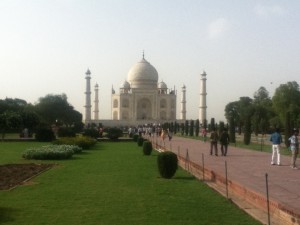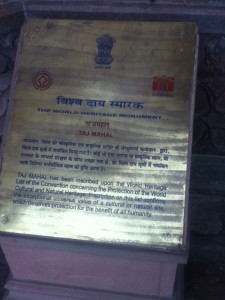By TIM ROSENKRANZ, 7/15/2014. The Taj Mahal is stunning, beautiful and breathtaking. I chose a trip to this world-famous tomb, as it is India’s most recognizable tourist site, a true global icon and vivid part of the global imaginary.
The Taj Majal, situated in the city of Agra, the former Mogul seat of power just three train-hours outside of New Delhi, is the epicenter of the region’s economy. It is quite fascinating to weave through all the layers and flows of economic activity that are tied around this architectural masterpiece. From local beggars to global marketers, generations of craftsman to travel agencies in Queens – the Taj sits like a spider in its web of commercial activity.
Tourist sites are works of translation. Here a myriad of actors translate history, landscapes, traditions, infrastructure and the lives of thousands of people (past, present and future) into a commoditized space. The function of this space is to produce and facilitate consumption of various forms.
During my two days in Agra, I experienced and observed various networks evolving around the different practices of consumption one can find in a tourist destination. All these instances of consumption follow different rules that enable their reproduction over time with changing actors (tourists) as continuous relations of consumption, production and exchange that make-up the tourist site Taj Mahal.
As my research is focusing on the role of the state within the triangle of the tourist and private industry, I was quite surprised by the various forms, in which the state appears in these relations. One of the most interesting ones is probably how the state on the one hand closes off certain spaces, while it on the other hand creates and endorses other spaces for specific practices.
The grounds of the Taj Mahal for example are off limits for the exchange of money. That does not mean that there is no economic activity going on. Photographers for example take pictures of tourists, which are then sold outside of the gates. These photographers are licensed by the state, even tough the final transaction of the relation to the tourist is removed from the inner circle of the tourist site.
Certain consumption spaces on the other hand are clearly endorsed by the state. A few craft shops for example are “state/government” shops. The local guides use these words often to create trust for the tourist. The attachment of the word “government” to a shop is supposed to make it a safe space for ‘fair’ exchange. Within the local structures of competition amongst craft shops, these “state/government” shops become privileged and dominant, creating an order that is not necessarily based on price and quality of goods, but the perception of trustworthiness.
These are just two specific arrangements of many, which I have sketched out here. They have ripple effects throughout Agra and if one follows the flows of people, goods and money that pass through these local economies, one will soon end up at intersections between them and could trace them to unexpected places far away. It is this interconnectivity that makes tourist sites such fascinating places to study. And it is also this interconnectivity that makes the actors closest to the site (and most dependent on it) the most vulnerable to changes within the network of relations.


